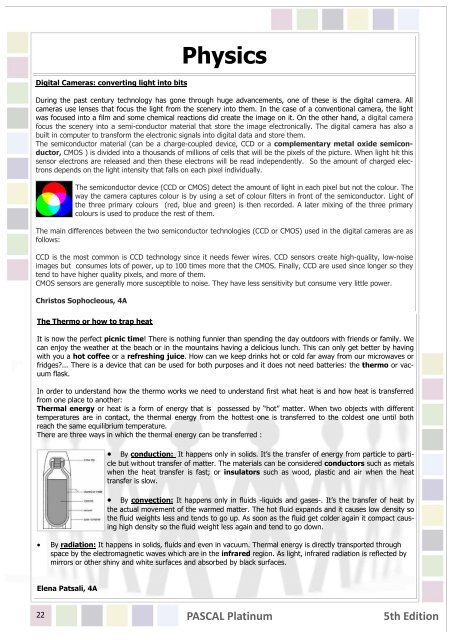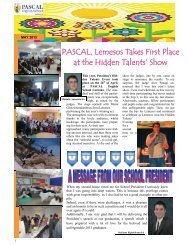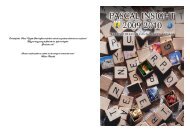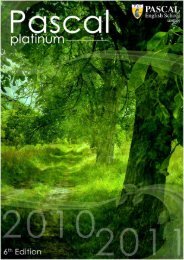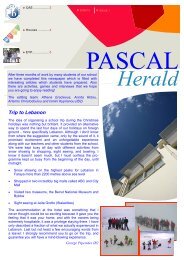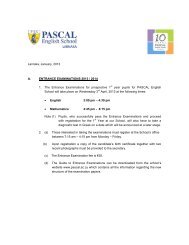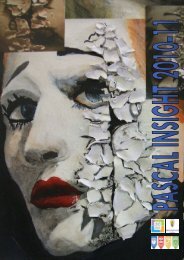PASCAL Platinum 5th Edition
PES_1010.pub (Read-Only) - Pascal Education
PES_1010.pub (Read-Only) - Pascal Education
- No tags were found...
You also want an ePaper? Increase the reach of your titles
YUMPU automatically turns print PDFs into web optimized ePapers that Google loves.
Digital Cameras: converting light into bitsPhysicsDuring the past century technology has gone through huge advancements, one of these is the digital camera. Allcameras use lenses that focus the light from the scenery into them. In the case of a conventional camera, the lightwas focused into a film and some chemical reactions did create the image on it. On the other hand, a digital camerafocus the scenery into a semi-conductor material that store the image electronically. The digital camera has also abuilt in computer to transform the electronic signals into digital data and store them.The semiconductor material (can be a charge-coupled device, CCD or a complementary metal oxide semiconductor,CMOS ) is divided into a thousands of millions of cells that will be the pixels of the picture. When light hit thissensor electrons are released and then these electrons will be read independently. So the amount of charged electronsdepends on the light intensity that falls on each pixel individually.The semiconductor device (CCD or CMOS) detect the amount of light in each pixel but not the colour. Theway the camera captures colour is by using a set of colour filters in front of the semiconductor. Light ofthe three primary colours (red, blue and green) is then recorded. A later mixing of the three primarycolours is used to produce the rest of them.The main differences between the two semiconductor technologies (CCD or CMOS) used in the digital cameras are asfollows:CCD is the most common is CCD technology since it needs fewer wires. CCD sensors create high-quality, low-noiseimages but consumes lots of power, up to 100 times more that the CMOS. Finally, CCD are used since longer so theytend to have higher quality pixels, and more of them.CMOS sensors are generally more susceptible to noise. They have less sensitivity but consume very little power.Christos Sophocleous, 4AThe Thermo or how to trap heatIt is now the perfect picnic time! There is nothing funnier than spending the day outdoors with friends or family. Wecan enjoy the weather at the beach or in the mountains having a delicious lunch. This can only get better by havingwith you a hot coffee or a refreshing juice. How can we keep drinks hot or cold far away from our microwaves orfridges?... There is a device that can be used for both purposes and it does not need batteries: the thermo or vacuumflask.In order to understand how the thermo works we need to understand first what heat is and how heat is transferredfrom one place to another:Thermal energy or heat is a form of energy that is possessed by “hot” matter. When two objects with differenttemperatures are in contact, the thermal energy from the hottest one is transferred to the coldest one until bothreach the same equilibrium temperature.There are three ways in which the thermal energy can be transferred :By conduction: It happens only in solids. It’s the transfer of energy from particle to particlebut without transfer of matter. The materials can be considered conductors such as metalswhen the heat transfer is fast; or insulators such as wood, plastic and air when the heattransfer is slow.By convection: It happens only in fluids -liquids and gases-. It’s the transfer of heat bythe actual movement of the warmed matter. The hot fluid expands and it causes low density sothe fluid weights less and tends to go up. As soon as the fluid get colder again it compact causinghigh density so the fluid weight less again and tend to go down.By radiation: It happens in solids, fluids and even in vacuum. Thermal energy is directly transported throughspace by the electromagnetic waves which are in the infrared region. As light, infrared radiation is reflected bymirrors or other shiny and white surfaces and absorbed by black surfaces.Elena Patsali, 4A22<strong>PASCAL</strong> <strong>Platinum</strong><strong>5th</strong> <strong>Edition</strong>


